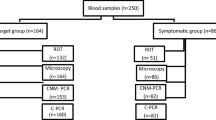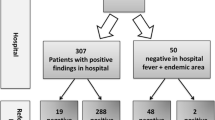Abstract
The aim of the present study was to evaluate the usefulness of quantitative nucleic acid sequence-based amplification (QT-NASBA) to detect Plasmodium spp. in diagnostic specimens of patients suspected of having malaria in a clinical setting in a non-endemic country. During the 4-month recruitment period, 113 patients were enrolled in the study, of which 93 were diagnosed as non-malaria and 20 as malaria cases on the basis of clinical and microscopic criteria. All microscopically positive cases had QT-NASBA counts of >0.1 parasites/µl and there was a significant positive correlation between the parasite counts obtained with both diagnostic methods. Of the 93 microscopically negative cases, six had a positive QT-NASBA result. Three of these cases had a recent history of malaria for which specific treatment was taken. In the other three cases there was no history of malaria and QT-NASBA results in these cases were near the cut-off level (>0.1 parasites/µl) of the test. The results demonstrate that QT-NASBA is a useful technology for the diagnosis of malaria in a reference laboratory, and it is very helpful in cases of low parasitemia.

Similar content being viewed by others
References
World Health Organization (1999) Malaria, 1982–1997. Wkly Epidemiol Rec 74:265–272
Wetsteyn JCFM, Kager PA, Gool T van (1997) The changing pattern of imported malaria in the Academic Medical Centre, Amsterdam. J Travel Med 4:171–175
Cobelens FG, Leentvaar-Kuijpers A (1997) Compliance with malaria chemoprophylaxis and preventive measures against mosquito bites among Dutch travellers. Trop Med Int Health 2:705–713
Bellmann R, Sturm W, Pechlaner C, Weiss G, Bellmann-Weiler R, Wiederman CJ, Patsch JR (2000) Imported malaria: six cases of severe Plasmodium falciparum infection in Innsbruck, Austria, within a period of 5 weeks. Wien Klin Wochenschr 112:453–458
Muentener P, Schlagenhauf P, Steffen R (1999) Imported malaria (1985–1995) trends and perspectives. Bull World Health Organ 77:560–566
Makler MT, Palmer CJ, Ager AL (1998) A review of practical techniques for the diagnosis of malaria. Ann Trop Med Parasitol 92:419–433
Compton J (1991) Nucleic acid sequence-based amplification. Nature 250:91–92
Chan AB, Fox JD (1991) NASBA and other transcription-based amplification methods for research and diagnostic microbiology. Rev Med Microbiol 10:185–196
Smits HL, Gussenhoven GC, Terpstra WJ, Schukkink RAF, Gemen B van, Gool T van (1997) Detection, identification and semi-quantification of malaria parasites by NASBA amplification of small subunit ribosomal RNA sequences. J Microbiol Methods 28:65–75
Schoone GJ, Oskam L, Kroon NCM, Schallig HDFH, Omar SA (2000) Detection and quantification of Plasmodium falciparum in blood samples using quantitative nucleic acid sequence-based amplification. J Clin Microbiol 38:4072–4075
Boom R, Sol CJA, Salimans AAA, Jansen CL, Wertheim-Dillen PME van, Noordaa J van der (1990) Rapid and simple method for purification of nucleic acids. J Clin Microbiol 28:495–503
Altman DG (1991) Practical statistics for medical research. Chapman & Hall, London, p 611
Campbell MJ, Machin D (1991) Medical statistics. Wiley, Chichester, p 172
Hänscheid T, Grobusch MP (2002) How useful is PCR in the diagnosis of malaria? Trends Parasitol 18:395–398
Author information
Authors and Affiliations
Corresponding author
Rights and permissions
About this article
Cite this article
Schallig, H.D.F.H., Schoone, G.J., Lommerse, E.J.M. et al. Usefulness of Quantitative Nucleic Acid Sequence-Based Amplification for Diagnosis of Malaria in an Academic Hospital Setting. Eur J Clin Microbiol Infect Dis 22, 555–557 (2003). https://doi.org/10.1007/s10096-003-0985-4
Published:
Issue Date:
DOI: https://doi.org/10.1007/s10096-003-0985-4




